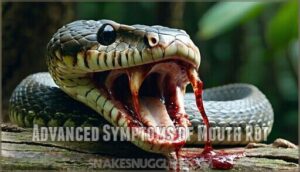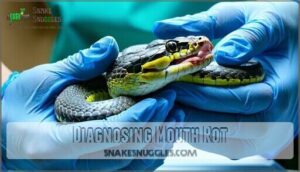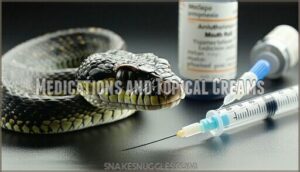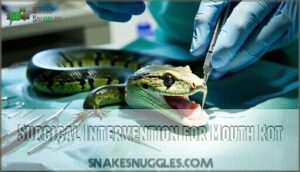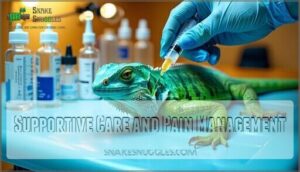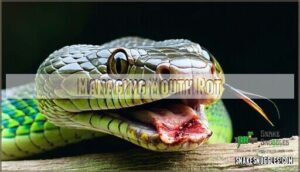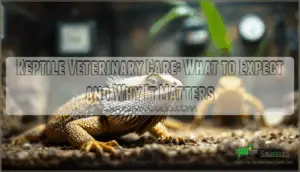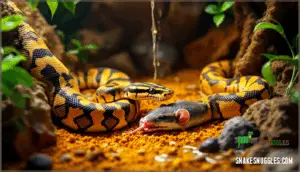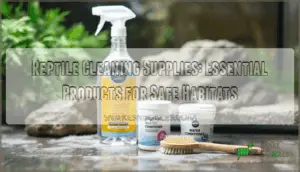This site is supported by our readers. We may earn a commission, at no cost to you, if you purchase through links.
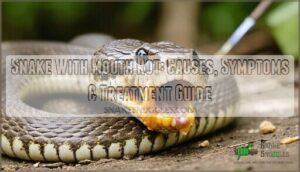 A snake with mouth rot shows thick, yellowish discharge around its mouth, swollen gums, and difficulty eating.
A snake with mouth rot shows thick, yellowish discharge around its mouth, swollen gums, and difficulty eating.
This bacterial infection, called stomatitis, develops when bacteria like Pseudomonas enter small wounds inside the mouth.
Poor husbandry, stress, or rough handling often trigger the condition, and you’ll notice your snake pawing at its mouth, refusing food, or keeping its mouth slightly open.
The infection spreads quickly and can become life-threatening if it reaches the respiratory system, making early detection essential to prevent what starts as minor irritation from rapidly escalating into a veterinary emergency requiring immediate professional treatment.
Table Of Contents
- Key Takeaways
- What is Mouth Rot
- Symptoms of Mouth Rot
- Diagnosing Mouth Rot
- Treating Mouth Rot
- Preventing Mouth Rot
- Managing Mouth Rot
- Frequently Asked Questions (FAQs)
- What to do if a snake has mouth rot?
- Can mouth rot be cured?
- Is mouth rot fatal in reptiles?
- How much does it cost to treat mouth rot in snakes?
- Can mouth rot spread to other snakes?
- How long does mouth rot take to heal?
- Is mouth rot fatal if left untreated?
- What foods help snakes recover from mouth rot?
- How much does mouth rot treatment typically cost?
- Conclusion
Key Takeaways
- Watch for early warning signs like yellowish discharge, swollen gums, difficulty eating, and mouth pawing – you’ll catch infections before they become life-threatening emergencies.
- Maintain pristine enclosure hygiene with weekly cleanings, fresh water every 3-4 days, and proper temperature gradients to prevent bacterial growth that leads to mouth rot.
- Seek immediate veterinary care when you spot symptoms – antibiotics and professional cleaning are essential since untreated mouth rot can spread to your snake’s respiratory system and become fatal.
- Address underlying stress factors like poor nutrition, temperature fluctuations, and mouth trauma from live prey to strengthen your snake’s immune system and prevent recurrence.
What is Mouth Rot
If you’re a snake owner, you’ve likely heard the term "mouth rot" whispered in reptile circles with the same concern as parents discuss head lice.
Mouth rot, also known as infectious stomatitis, is a bacterial or fungal infection that attacks your snake’s mouth and can quickly turn from a minor issue into a serious health threat if left untreated.
Definition of Mouth Rot
Mouth rot, officially known as infectious stomatitis, is a bacterial or fungal oral infection that affects snakes.
This snake disease develops when harmful bacteria like Pseudomonas or fungi invade your pet’s mouth tissues.
The condition creates painful oral lesions and necrotic tissue, making it one of the most common health issues in captive reptiles requiring immediate veterinary attention.
Causes of Mouth Rot
Understanding what triggers snake mouth rot causes helps you protect your pet.
Poor nutrition and mouth trauma create openings for bacterial culprits and fungal infections to take hold. When your snake’s compromised immune system meets environmental stressors, trouble follows.
One potential issue is infectious stomatitis, a bacterial infection that can cause serious problems.
Common causes include:
- Bacterial culprits like Pseudomonas and E. coli invading through wounds
- Hygiene factors such as dirty water and contaminated bedding
- Immune compromise from stress, illness, or temperature issues
- Environmental stressors including overcrowding and poor habitat conditions
- Mouth trauma from live prey bites or cage rubbing
Risk Factors for Mouth Rot
Several factors stack the deck against your snake’s oral health.
Poor hygiene in enclosures creates bacterial breeding grounds, while mouth trauma from live prey or rough surfaces opens infection pathways.
Stress and immune suppression from temperature inaccuracy make your snake vulnerable to opportunistic pathogens.
Recognizing that bacterial colonization is a primary cause of mouth-rot is essential for prevention.
| Risk Category | Primary Factors | Impact Level |
|---|---|---|
| Environmental | Unsanitary housing, inappropriate temperature | High |
| Physical | Mouth trauma, live prey feeding | High |
| Health | Poor nutrition, immune suppression | Medium |
| Behavioral | Stress, overcrowding | Medium |
Symptoms of Mouth Rot
Recognizing mouth rot symptoms early can save your snake’s life and prevent serious complications. You’ll notice several telltale signs that indicate your pet needs immediate veterinary attention.
Early Detection Signs
Catching snake mouth rot early can save your pet’s life and prevent serious complications.
Watch for these warning signs:
- Appetite Changes – Your snake refuses food or shows decreased interest in meals
- Excessive Salivation – Notice unusual drooling or wet mouth areas
- Redness and Swelling – Gums appear inflamed or mouth tissues look irritated
- Mouth Asymmetry – One side of the face appears different or swollen
- Behavioral Shifts – Your snake becomes lethargic or displays unusual aggression
Visible sores may indicate underlying bacterial infections.
Visible Indicators of Mouth Rot
You’ll easily spot snake mouth rot symptoms through several key visual changes.
Oral lesions appear as red, swollen areas or blister-like sores around the mouth.
Facial asymmetry develops when one side becomes more swollen than the other.
Saliva changes include excessive drooling or thick, discolored discharge.
Swollen mouth tissues create visible puffiness, while appetite loss becomes apparent when your snake refuses food consistently.
Advanced Symptoms of Mouth Rot
When mouth rot progresses, you’ll notice open-mouth breathing as your snake struggles with severe oral inflammation.
Advanced mouth rot transforms your snake into a mouth-breathing patient struggling against severe oral inflammation.
Systemic infection may develop, causing extreme lethargy and potential organ involvement.
Tooth loss becomes apparent, while facial asymmetry creates obvious distortion.
The swollen mouth produces thick discharge with persistent bleeding. These advanced snake mouth rot symptoms require immediate veterinary intervention to prevent life-threatening complications, including severe oral inflammation.
Diagnosing Mouth Rot
If you suspect your snake has mouth rot, getting a proper veterinary diagnosis is essential for effective treatment.
A reptile veterinarian will conduct a thorough examination and run specific tests to confirm the infection and identify the underlying cause, which is crucial for effective treatment.
Veterinary Examination Process
When you suspect mouth rot, your vet will start with a thorough physical inspection of your snake’s oral cavity, examining the gums, teeth, and throat for signs of infection.
They’ll perform careful sample collection through swabbing techniques to gather discharge or tissue samples.
Imaging techniques like X-rays may be used to assess bone involvement, while culture analysis helps identify specific bacteria causing the infection.
Laboratory Tests for Mouth Rot
Your vet will order several lab tests to pinpoint the exact cause of your snake’s mouth rot.
Swabs from infected areas undergo culture sensitivity testing to identify specific bacteria and determine which antibiotics work best.
Cytology analysis examines cells under a microscope, while Gram staining differentiates bacterial types.
PCR testing detects hard-to-culture pathogens, and fungal identification confirms any secondary infections.
Ruling Out Other Diseases
Your vet won’t stop at confirming snake mouth rot—they’ll play detective to rule out other conditions that mimic oral lesions. Think of it as eliminating suspects in a medical mystery.
Here’s what they’ll investigate:
- Respiratory Infections – Upper respiratory issues can cause mouth breathing and oral discharge that looks like mouth rot
- Metabolic Disease – Nutritional deficiencies create similar symptoms, requiring blood work and parasite exclusion testing
- Cancer Screening – Tumors and viral testing help distinguish between infectious causes and neoplastic growth through differential diagnosis
Treating Mouth Rot
When your snake shows signs of mouth rot, prompt treatment is essential to prevent the infection from spreading.
The good news is that with proper veterinary care and the right approach, most snakes recover fully from this condition.
Medications and Topical Creams
Your snake’s treatment arsenal includes powerful antibiotic options like enrofloxacin and ceftazidime targeting bacterial infections.
Antifungal treatments such as ketoconazole handle fungal cases. Topical creams containing silver sulfadiazine promote healing after antiseptic cleaning.
Pain relief medications reduce discomfort while medicated solutions like dilute betadine cleanse infected areas. Follow dosage guidelines carefully—antibiotic treatment duration typically spans 10-14 days for ideal recovery.
Untreated cases can even progress to systemic bacterial infections, which is a serious health risk that requires immediate attention to prevent further complications, ensuring the use of proper medication.
Surgical Intervention for Mouth Rot
When medications aren’t enough, your vet might recommend surgery.
Surgical treatment involves removing dead tissue and infected material from your snake’s mouth using specialized debridement techniques.
This procedure requires anesthesia, which carries some risks for reptiles.
Surgery becomes necessary when jawbone infection develops or severe tissue damage occurs.
Your vet will discuss surgical alternatives before proceeding with debridement.
Supportive Care and Pain Management
Beyond surgery, your snake needs thorough supportive care to recover fully.
Fluid therapy helps maintain hydration when eating becomes painful. Heat support maintains proper body temperature for immune function.
Nutritional support may include assisted feeding or liquid nutrition. Meloxicam provides effective pain management, with dosage determined by your vet.
Proper snake medication is essential for recovery. Stress reduction through quiet environments and minimal handling accelerates healing.
Monitor snake discomfort levels and adjust supportive care accordingly to ensure a smooth recovery with proper management.
Preventing Mouth Rot
You can prevent mouth rot in your snake by maintaining proper hygiene and creating an ideal environment.
The best defense against this painful condition is consistent care that addresses the underlying factors that weaken your snake’s immune system.
Proper Snake Care and Hygiene
Prevention starts with creating the right foundation. Clean environment maintenance prevents bacteria and fungi from gaining a foothold in your snake’s mouth.
Focus on these key hygiene practices:
- Enclosure sanitation: Clean surfaces weekly with reptile-safe disinfectants
- Water quality: Replace water every 3-4 days, scrub bowls thoroughly
- Handling techniques: Wash hands before and after snake contact
- Shedding assistance: Remove stuck shed around mouth areas gently
- Diet variety: Offer appropriately-sized prey to prevent oral injuries
For proper cleaning, consider using reptile-safe cleaning products.
Reducing Stress and Improving Habitat
Creating a stress-free environment is your snake’s best defense against mouth rot.
Proper temperature gradients between 75-85°F, humidity levels at 50-60%, and multiple hiding spots reduce snake stress substantially.
Choose appropriate substrate choices like cypress mulch or paper towels for easy cleaning.
Enclosure enrichment with branches and plants promotes natural behaviors.
Consider habitat enrichment products to stimulate natural behaviors.
A cleaner cage with proper snake environment setup prevents the conditions that lead to snake mouth rot by supporting your snake’s immune system naturally.
Regular Veterinary Check-Ups
Regular checkups with your reptile vet provide the best defense against mouth rot through early detection and preventative care.
Your snake vet can spot subtle warning signs before they become serious problems, saving you money and stress down the road.
- Schedule annual wellness exams for health monitoring and expert advice
- Discuss proper husbandry practices to prevent environmental stressors
- Establish baseline health records for future comparison during illness
- Get personalized care recommendations based on your snake’s specific needs
Managing Mouth Rot
Once you’ve started treatment for your snake’s mouth rot, you’ll need to provide careful home care and monitor their recovery closely.
Managing this condition requires patience and consistency, as healing can take several weeks depending on the severity of the infection.
Home Care and Recovery Tips
When treating snake mouth rot at home, focus on wound cleaning with veterinary-approved antiseptic solutions.
Maintain proper habitat maintenance by ensuring clean water, appropriate temperatures, and sanitized enclosures. Support snake recovery through stress reduction techniques like minimizing handling and providing secure hiding spots.
Adjust feeding techniques by offering smaller, softer prey items. Monitor hydration methods carefully, ensuring fresh water availability.
These snake care practices complement professional mouth rot treatment for ideal snake mouth rot recovery. Remember that poor hygiene contributes to mouth rot development, emphasizing the importance of proper hygiene and clean environment.
Monitoring Progress and Adjusting Treatment
Success hinges on vigilant tracking of your snake’s healing journey. Watch for subtle changes that signal whether snake mouth rot treatment is working effectively.
Here’s your monitoring checklist:
- Treatment Efficacy – Document appetite improvements and reduced mouth swelling within 5-7 days
- Dosage Adjustments – Note if antibiotics aren’t clearing infection; your vet may modify prescriptions
- Antibiotic Resistance – Report persistent symptoms that could indicate bacterial resistance requiring different medications
- Relapse Prevention – Monitor for recurring discharge or inflammation even after apparent recovery
- Long-Term Monitoring – Schedule follow-up exams to confirm complete healing and prevent future episodes
Long-Term Prognosis for Snakes With Mouth Rot
When caught early, your snake’s mouth rot prognosis is excellent—survival rates reach 80-90% with prompt treatment.
However, recurrence rates climb if you don’t address underlying husbandry issues.
Treatment outcomes depend heavily on infection severity and your snake’s overall health.
Long-term complications like chronic lesions or feeding difficulties can impact quality of life, requiring dietary adjustments and ongoing veterinary monitoring for effective snake disease management.
Frequently Asked Questions (FAQs)
What to do if a snake has mouth rot?
Immediately take your snake to a reptile veterinarian for professional diagnosis and treatment. They’ll prescribe antibiotics, clean infected tissue, and address underlying causes like poor husbandry conditions.
Can mouth rot be cured?
Yes, mouth rot can be cured with proper veterinary treatment. You’ll need antibiotics, mouth cleaning, and addressing underlying causes like poor husbandry. Early detection and treatment substantially improve success rates.
Is mouth rot fatal in reptiles?
Like a ticking time bomb, mouth rot can become fatal if you don’t treat it promptly.
However, with proper veterinary care and antibiotics, most reptiles recover completely from this bacterial infection.
How much does it cost to treat mouth rot in snakes?
Treatment costs typically range from $150-$500, depending on severity. You’ll pay for veterinary exams, diagnostic testing, antibiotics, and potential sedation for mouth cleaning. Early intervention saves money.
Can mouth rot spread to other snakes?
Mouth rot isn’t directly contagious between snakes, but you’ll want to separate affected animals.
The bacteria causing infection can spread through contaminated water, surfaces, or equipment, potentially infecting other snakes with compromised immune systems, which is a key factor to consider for prevention.
How long does mouth rot take to heal?
Healing happens gradually, taking several weeks to months depending on severity and treatment compliance.
You’ll notice improvement within days of proper antibiotic therapy, but complete recovery requires patience and consistent care.
Is mouth rot fatal if left untreated?
Yes, mouth rot can be fatal if you don’t treat it. The infection can spread to your snake’s bloodstream and internal organs, causing systemic illness and potentially death.
What foods help snakes recover from mouth rot?
As the saying goes, "you can’t heal a wound while still picking at it".
You’ll need to focus on easy-to-digest foods that won’t irritate your snake’s mouth while recovering from this infection.
How much does mouth rot treatment typically cost?
Treatment costs vary widely, but you’ll typically spend $200-$800 for veterinary care. Diagnostic tests, antibiotics, and follow-up visits add up quickly. Severe cases requiring surgery can cost substantially more.
Conclusion
Remember the old saying: "An ounce of prevention is worth a pound of cure"?
That’s especially true when dealing with a snake with mouth rot.
You’ve learned that early detection, proper husbandry, and prompt veterinary care are your best defenses against this serious condition.
By maintaining clean enclosures, monitoring your snake’s behavior, and seeking professional help at the first sign of trouble, you’ll keep your reptile healthy and happy for years to come, which is the ultimate goal of proper husbandry.
- https://wvj.science-line.com/attachments/article/78/WVJ%2013(3),%20409-419,%20September%2025,%202023.pdf
- https://www.thebhs.org/publications/the-herpetological-bulletin/issue-number-52-summer-1995/2585-hb052-08/file
- https://www.dialavet.com/blog/mouth-rot-in-snakes
- https://vethelpdirect.com/vetblog/2021/03/21/what-is-mouth-rot-in-snakes-and-why-does-it-occur/
- https://www.petplace.com/article/reptiles/general/mouth-rot-infectious-stomatitis-ulcerative-stomatitis



